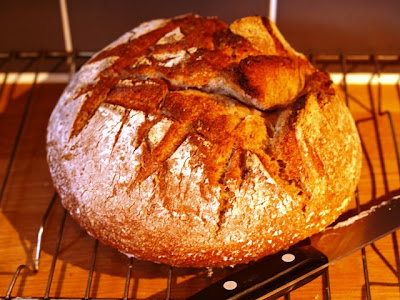My pets are now relaxing in the back of the fridge
Look at what my domesticated creatures made. I've never been much of a pet person (to put it mildly). We have a dog, but that's Lynda's. I once had a grasshopper, trapped in a small house I made from Lego. It was probably a Yellow Wing, as we called it; presumably a locust. But that was cruel and a long time ago.
Now I have my microbial association. I don't know how old the creatures are but I like to think their ancestors lived here in the early eighteenth century, when our house at Kew was the Housekeeper's Cottage for the White House, home to George III for a while but demolished in 1802. Alternatively they may have entered the premises during the time the neighbouring cottage was used as a brewery, some time through its 280 or so year history (when I open the jar containing my yeast it sure smells like beer).
This is the source my microbes - somewhere near the coffee machine and conical burr grinder in the far corner. To capture my pets I mixed some flour and warm water, whisking it with a small piece of rhubarb stem trimmed from Lynda's then rather small rhubarb plant (which survived my butchery and is now ready for a serious harvest). I then covered my creamy batter and waited a day or so for bubbles and a beery smell. By the way, I have no idea why the rhubarb but that's what the recipe said.
That was it. Caught. Six months ago All I had to do then was feed it every day, with flour and water. So easy to care for and instead of unconditional love I get a loaf of bread every now and then. Of course I got sick of feeding it after a few weeks so it mostly spends time in the back of our fridge until I get inspired enough to resurrect it over a few days and subculture some for baking.
My sour-dough starter most likely contains a few lactic acid bacteria (one or more of about 50 species, mostly in the genus Lactobacillus) and a yeast or two (from more than 20 species of mostly Saccharomyces or Candida). So my pet is best described as a microbial association. The yeast leavens the bread, the bacterium makes it sour. More or less.
In a recent study on the microbes in commercial and home sour-doughs, the dominant yeasts in the bakery were Saccharomyces cerevisiae and Wickerhamomyces anomalus, while at home (or in fact in the laboratory in this case) the Saccharomyces was replaced by Candida glabrata. The conclusion of this study was that the Candida probably came from a contamination by commercial baker's yeast. Their laboratory microbes, they argued, all came from the flour.
In our kitchen the microbial association came either from a) the flour, b) the microbial flora active in our kitchen and perhaps a lineage nearly three centuries old or c) some stray commercial yeast from the last time I used dried or fresh product for bread. Or else a mix of a+b+c. Whatever the source, the bread tasted good and my pets are now relaxing at the back of the fridge.
Images: Bread is all mine. Kitchen is in our cottage. Yeast are borrowed from Foodists.



Comments